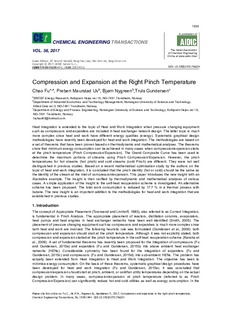Compression and expansion at the right pinch temperature
Journal article, Peer reviewed
Published version
Permanent lenke
http://hdl.handle.net/11250/2466474Utgivelsesdato
2017Metadata
Vis full innførselSamlinger
Originalversjon
10.3303/CET1756324Sammendrag
Heat Integration is extended to the topic of Heat and Work Integration when pressure changing equipment such as compressors and expanders are included in heat exchanger network design. The latter topic is much more complex since heat and work have different energy qualities (exergy). Systematic graphical design methodologies have recently been developed for heat and work integration. The methodologies are based on a set of theorems that have been proven based on thermodynamic and mathematical analyses. The theorems show that minimum exergy consumption can be achieved in many cases when compression/expansion starts at the pinch temperature (Pinch Compression/Expansion). The Grand Composite Curve has been used to determine the maximum portions of streams using Pinch Compression/Expansion. However, the pinch temperatures for hot streams (hot pinch) and cold streams (cold Pinch) are different. They were not well distinguished in previous studies. Based on a recent mathematical optimisation study by the authors on the topic of heat and work integration, it is concluded that the pinch identity (hot or cold) should be the same as the identity of the stream at the inlet of compression/expansion. This paper introduces the new insight with an illustrative example. The insight is then verified by thermodynamic and mathematical analyses of various cases. A simple application of the insight to the self-heat recuperation scheme is investigated. An alternative scheme has been proposed. The total work consumption is reduced by 17.7 % in a thermal process with butane. The new insight is an important addition to the methodologies for heat and work integration that are established in previous studies.
